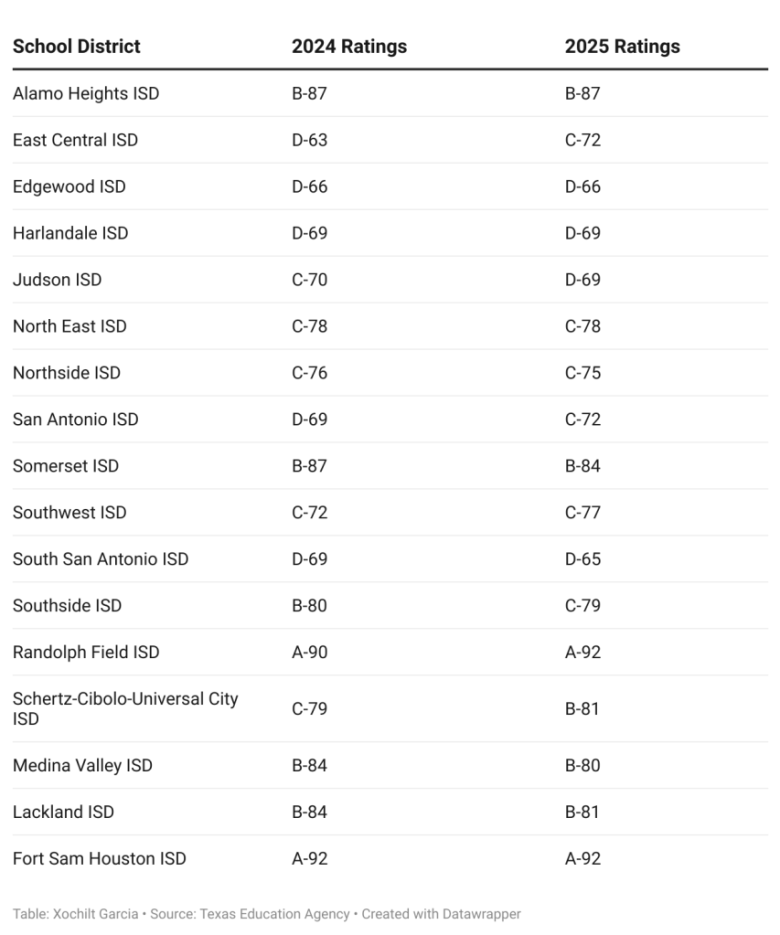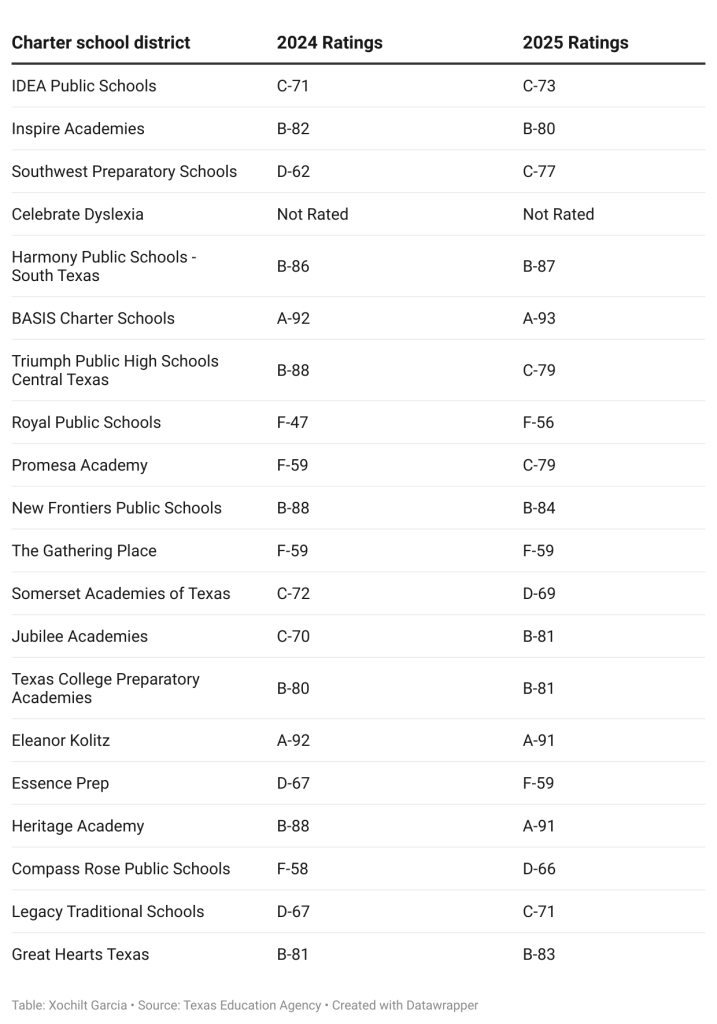In San Antonio, five independent school districts and 12 charter districts saw some improvement in school ratings during the most recent round of A-F scores released by the state on Friday.
The state’s letter grade ratings reflect how well schools are educating its students. The accountability system has its critics.
While visiting North East ISD’s Harmony Hills Elementary on Friday, Texas Education Commissioner Mike Morath said it’s a system that reveals the gaps between what students know and don’t know.
Morath maintains that any school, regardless of poverty rates or racial makeup, can earn an A rating. Harmony Hills went from a score of 77 to a 91 this year.
“It was a high-level of growth for a broad group of students,” Morath said. Most students at the school are Hispanic and 75% of students are considered economically disadvantaged by the state.
Across the state, nearly a third of campuses improved their letter grade while most campuses maintained their previous ratings. Only 15% of Texas campuses saw a decline.
San Antonio schools followed the same trend of overall improvement with only a handful receiving lower ratings.
San Antonio area school districts see some improvement

More than a third of public school districts in the San Antonio area, charter and traditional, saw an improved score. Only three ISDs went up a letter grade — East Central ISD, San Antonio ISD and Shertz-Cibolo-Universal City ISD.
Notably, the biggest improvement was seen by East Central ISD, which has a student enrollment of more than 12,000. Last year, the district earned a 63, and this year the state scored the district a 72, or a C rating. No campus within ECISD received an F rating this year either.
“This momentum is real — and we’re just getting started,” said ECISD Superintendent Roland Toscano in a statement on Friday.
San Antonio’s three largest school districts — San Antonio ISD, Northside ISD and North East ISD — all got C ratings. SAISD improved from last year to this year, going from a 69 to a 72. In 2023, SAISD had received a C.
Only two school districts, Fort Sam Houston ISD and Lackland ISD both located on military bases, have A ratings.
Local charter schools districts see biggest gains

Larger gains in the area were seen by local charter districts. Southwest Preparatory Schools, which has six schools, went from a D-rating to a C-rating.
Promesa Academy Charter School, which only has one campus on the West Side with less than 300 students, went from an F-rating to a C-rating. Jubilee Academies, which has a handful of campuses in San Antonio, went from a C to a B.
At least three charter districts in the area went down a letter grade by a few points.
A-F rating system could change
Released at the same time as the 2024-25 ratings, the 2023-24 ratings came out a year late because the data was caught up in court proceedings, a result of some school districts trying to block the state from releasing the scores.
The school districts’ reasoning: the Texas Education Agency went too far in updating the benchmarks that measure college readiness. State law requires the agency to update the rating system every five years, and ultimately, a judge ruled that Morath did not overstep when he updated the system.
Some education policy experts say a consistent accountability rating system is necessary across the state, and had previously put pressure on state courts to release ratings for the 2023-24 and 2022-23 school years, which involved separate lawsuits filed by school districts looking to block ratings from coming out.
 Rawlinson Middle School teachers welcome students to campus with waves, cheers and a hand-made sign during morning drop-off on the first day of school Aug. 11, 2025.
Rawlinson Middle School teachers welcome students to campus with waves, cheers and a hand-made sign during morning drop-off on the first day of school Aug. 11, 2025.
Credit: Amber Esparza for the San Antonio Report
Families are allowed to request a school transfer if the campus their student attends has a low rating.
District officials, however, say state ratings do not reflect the full scope of academic effectiveness since they rely heavily on state standardized testing.
“We know that every school in NISD, regardless of its Texas Education Agency rating, is dedicated to continuous improvement,” said Barry Perez, a spokesperson for the district, which has an enrollment of roughly 99,000 students and 127 campuses.
NISD’s kept the same letter rating, though it dropped by one point compared to last year.
In a letter to families, SAISD superintendent Jaime Aquino said the district is “headed in the right direction.”
Aquino pointed to a 35% decrease in the number of D- and F-rated campuses at SAISD compared to last year, adding that nearly two thirds of schools earned a C or better, up from just under half in 2025.
State ratings are not perfect though, Aquino has said several times.
That’s why SAISD is working on its own school performance system, which could be implemented as early as this school year and which gives more weight to categories outside of standardized testing scores.
The state’s accountability system could soon face changes, too, as state lawmakers consider replacing the yearly STAAR with three shorter tests taken throughout the school year, an effort that has bipartisan support.
Earlier this month during a special session, the Texas Senate passed Senate Bill 8, which would redesign standardized testing.
Morath said the bill would not “fundamentally change” the ratings system, but would help families receive test results faster, making academic intervention efforts for struggling students easier.
